Last year, during our 20th anniversary, I reflected on how Constructive’s values have guided who we are, what we do, and why we do it. As a purpose-driven, social impact agency, values are woven into our culture. They’re expressions of who we are and who we want to be that can be seen and experienced in everything we do. In reflecting on how to better focus our brand and add even greater meaning to our purpose, we sought to go higher. Literally. As part of our strategic planning work this year, Constructive’s leadership team worked with our advisor to add a Higher Purpose to our brand strategy that’s deepened our commitment to each other and to our work. Which, of course, got me thinking about nonprofit brand strategy and how we can help social impact organizations elevate the purpose in their own missions.
Why Add a Higher Purpose to Your Nonprofit’s Brand?
When we first started discussing a Higher Purpose, I wasn’t sure—it sounded a bit too “woo woo” spiritual for me. But as we explored the idea further, I quickly became one of the converted. The idea of adding a Higher Purpose to your brand is to define a single word or short phrase that encapsulates the biggest why for what it is you do. One idea that’s at the core of everything you do and why you do it—both for yourself and for the world. The key is to make it very simple, unlike a mission statement, which is usually wordy. That’s what makes it so powerful and expansive.
When thinking about your nonprofit’s brand and brand strategy, it’s important to remember the importance it plays in strengthening organizational capacity and cohesion to increas impact. The simplicity and loftiness of a Higher Purpose complements mission and vision work extremely well (so much so that we’ll likely be adding it to Constructive’s brand strategy process). Once you identify your nonprofit brand’s Higher Purpose, it’s a little bit of magic. The ideas just start flowing. All of a sudden, your Higher Purpose is seemingly everything. For me, it gave my rational, creative, and ethical mind so much room to roam.
For Constructive, our Higher Purpose, “Engagement,” is both how we want to be and how we’d like the world to be. Engagement is the through-line that connects our mission and our values. It’s at the core of both the thing we’re in pursuit of and the beliefs that guide us in that pursuit. It contains multitudes—both a North Star and a universe unto itself.
The process of establishing a Higher Purpose for your nonprofit brand is dead-simple:
1) Collectively define a word or short phrase that embodies as much of the what, why, how, and who of your mission.
2) Riff!
The results really are magic. Whether you’re a nonprofit, a foundation, a government agency, or a social impact enterprise, establishing your Higher Purpose will quickly become clarifying and offer so many avenues for shaping your work, your culture, and your impact. It effortlessly creates focus and expands possibilities at the same time—a powerful combination. Talk about crystallizing the purpose of your purpose-driven brand!
What’s this look like?
After exploring different ideas and concepts, Constructive’s team settled on “Engagement” for our brand’s higher purpose. And once we did, here’s how we defined what engagement means for the world and for ourselves.
Why Engagement Matters for the World We Want to Live In
Engagement is essential to an equitable society. As our engagement widens, our social impact increases. It’s a dynamic series of concentric, virtuous, widening circles: an engaged person can become an engaged citizen, which can create an engaged community, which can create an engaged society.
Engagement is the antidote for apathy. A world with apathy is the greatest threat to progress. When we are engaged, we instantly recognize the importance of the people and issues that we care about—and by sustaining that engagement, it’s impossible not to care.
Engagement is a sign of respect. It requires us to care, tune in, and pay attention with great intent. The deeper our level of engagement, the more we demonstrate our commitment and how much we value the people and things that we engage with.
Engagement is essential to collaboration. Co-creating solutions and designing new ways forward for people and the planet requires us to collaborate. The greater our engagement with our collaborators in that process, the bigger the space we create for meaningful contributions.
Engagement is a commitment to learning. To be engaged is to accept an invitation to greater understanding, appreciation, and contribution. It’s the essence of getting better every day in whatever it is we do—and who we want to be.
Engagement is the foundation of partnership. Whether between individuals, groups, or communities, being engaged is to cultivate an appreciation for everyone’s value and interests, and for what we have to offer. As a result, everyone contributes and everyone receives something meaningful in return.
Engagement cultivates awareness, understanding, and empathy. By paying attention with purpose we can better place the things in which we’re engaged in context and capture the essence of their direct and indirect impact on people and the planet.
Engagement generates action. Whether our engagement is mental, emotional, or physical, the greater our engagement, the more likely it is that our actions will create the results that we are looking for.
What Engagement Means for Constructive’s Brand
Whether it’s in our work or the world in which we live, being deeply engaged in what we are doing, who we are doing it for, and why we are doing it is the foundation for being deeply fulfilled.
As a collaborative, consultative strategy and design firm that works with social impact organizations to solve complex problems, we must be deeply engaged— with the work that we are doing, how we are doing it, the people we are doing it with, and those that we are doing it for.
Our clients in the social impact space are profoundly engaged in the issues on which they work. To be the type of partner they need and deserve—and to be our best at helping them achieve our shared goals, we must be equally engaged.
Advancing social change takes time and requires partners and allies. The success of Constructive’s clients in realizing the change they seek depends on how well we help them engage their audiences to join in the effort.
The more deeply we engage in understanding the people we design for, the more effective we will be in designing experiences that engage them—that connect with meaning to who they are, their needs, and their aspirations.
Engaging with goals in mind is the essence of effective design: committing oneself to fully understanding an existing situation and then problem solving to make it better.
Producing great work requires deep focus and great attention to detail—both hallmarks of being deeply engaged. This is particularly true in collaborative, complex work, where our strategic, creative, and technical choices impact the work of others.
Our work and our success are based on partnership with our clients, our partners, and each other. The quality of these relationships depends on how deeply engaged we are in our partnerships.
To sustain long-term relationships we must remain engaged, paying close attention to their needs and aspirations, and being proactive about how we can help fulfill them.
Our commitment to our craft and to our clients is demonstrated by how deeply engaged we are in producing great work—and the results speak for themselves when others experience it.
When the going gets tough, we must stay engaged. The difference between success and failure often hinges on how we handle situations when they aren’t easy or aren’t going our way. Our level of engagement reflects our level of focus, care, and commitment—all essential to delivering great results.
Maybe I’m drinking my own Kool Aid here, but this feels like pretty powerful stuff! And even better, it feels like we’ve only just begun. That’s the hidden beauty of a Higher Purpose for your brand. Unlike brand values (which are absolutely essential), a Higher Purpose provides a singular focus that can be deeply explored—and focus is one of the most important things to a successful brand.
Moving forward, not only will defining a Higher Purpose be integrated into Constructive’s brand strategy process, it will also be reflected in who we are, what we do, and why it matters—the very essence of our own brand. And for social impact organizations thinking about how internal branding unites their people, I’d say give adding a Higher Purpose to your nonprofit’s brand strategy a try—you’re likely to be amazed by the ideas and energy it unlocks.
Nonprofit annual reports are a cornerstone of many organizations’ communications strategies and there are a lot of ways to approach designing an annual report—especially if your considering designing an interactive nonprofit annual report. In nonprofit annual report design, each year brings a new opportunity to create something that shares your organization’s impact—and tells the stories that bring this impact to life. Staying on top of trends helps make sure that your nonprofit’s annual report stands out and engages your most important audiences.
One of those trends is whether creating a digital annual report is worth the time and investment for your nonprofit over designing a PDF annual report. Digital publishing for reports is hardly new, but living through 2020, with many of us working from home, has elevated the value of a digital annual report for nonprofits who need to engage their most important audiences—particularly for fundraising. Because, when you can’t easily hand an annual report to someone in a personal meeting and you’re also not sure if you can mail it to their office, the value of a digital annual report starts to make a lot more sense.
This year, we channeled our energy into designing an interactive digital annual report for The Legal Aid Society. We’ve created annual reports for them in the past. However, print annual reports were always their priority. But Covid pushed us and The Legal Aid Society to take a different approach. So, we shifted gears and prioritized designing an interactive annual report—with the PDF version taking a back seat.
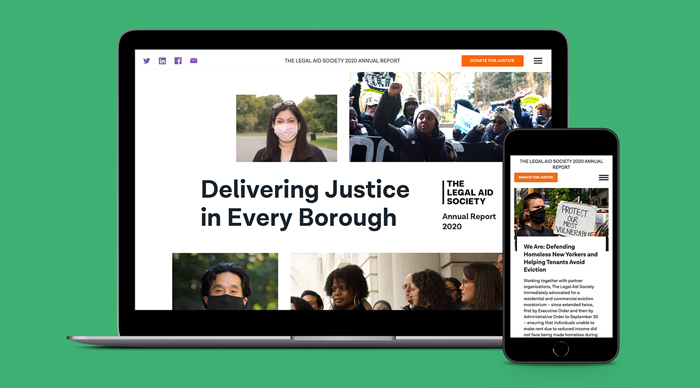
A New Vision for Nonprofit Annual Report Design
As the pandemic brought most in-person interactions to a halt in New York City, The Legal Aid Society’s typical strategy for distributing their annual reports shifted. Instead of distributing them primarily in-person during their Annual Meeting, this year they would need to distribute their annual reports digitally. Instead of moving the static annual report to a digital format where it would appear as a single-page, scrolling document, we decided to use this as an opportunity to provide The Legal Aid Society’s clients and stakeholders with a more interactive experience.
We pitched a multi-page, interactive annual report to The Legal Aid Society that would be more user-friendly and provide readers with an immersive digital experience. And for the print-inclined, the digital report also includes a downloadable PDF report.

Nonprofit Digital Annual Report Design with a Content-First Approach
Since we were creating a multi-page digital annual report, we approached things a little differently than usual. Instead of presenting The Legal Aid Society with a site map and walk-through of how the navigation would be structured, we took a content-first approach. We went a level deeper to think about what content would be hosted on each page of the site and how we envisioned these pages being interrelated. Our wireframes, then, grew organically out of these content selection and layout phases.
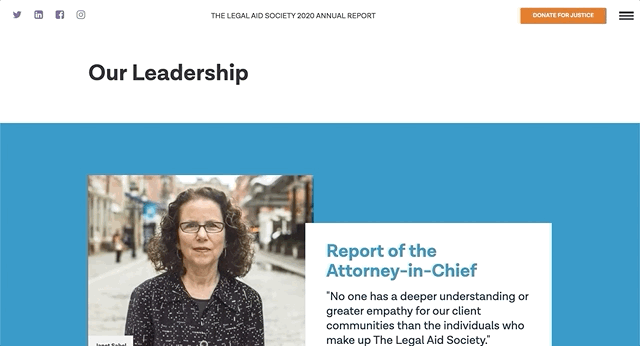
UX Design That Caters to Audiences’ Mental Models
We created an HTML-based site to host The Legal Aid Society’s digital annual report. The main question that guided our design was, “how would a user flow through this information?” Since the annual report was a multi-page experience, we knew a user wouldn’t be going through it in a linear fashion, as one does when reading a static annual report, from beginning to end. Even so, we wanted to make sure that we kept users’ mental models front and center when designing this annual report so that they would still be able to progress through the content from page to page, in a logical, even if not linear, manner.
We also enhanced readability through user interface elements. For example, the annual report included letters from executive staff, but instead of just presenting them in a static format, we loaded them in elements that slid out from the side of the report. This created the experience of reading a letter on the screen for the user rather than simply reading it in-line on a page.
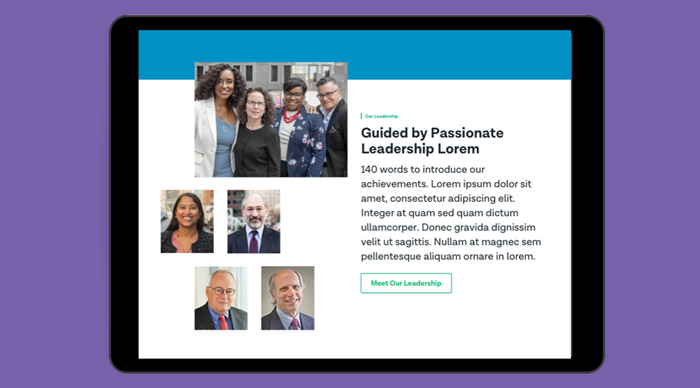
Interactive Annual Report Design that Drives Engagment
Since we previously worked with The Legal Aid Society to design the nonprofit law firm’s branding and website, as well as multiple annual report designs, we already had a design system in place. To keep brand continuity intact, we drew on the same design elements, including typography, photo treatment, and color palettes.
For typography, we used type overlaid on photos with a box, picking up on design cues from the main site. Additionally, we used bolder and larger numbers for statistics to immediately draw the reader’s attention to them, a design practice we implemented both on the main site and in previous annual reports for The Legal Aid Society.
For the digital annual report, while we continued to use the same color palette we used for the rest of The Legal Aid Society brand, we incorporated larger color fields to break things up a little and create better pacing as one goes through the report. While in one way, our use of color aligned the annual report with The Legal Aid Society brand, in another, readers also got the sense that they weren’t on their main site and were partaking of a distinct experience.
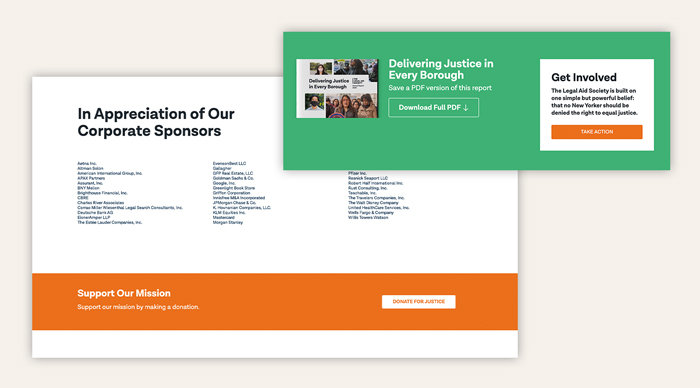
An Annual Report That Leverages the Main Website
Designing a more robust nonprofit digital annual report also expanded our opportunities to design for engagement. With more stories and information to explore—and more content to engage with—we had more places to engage audiences to learn about The Legal Aid Society. And because they have invested significantly in making sure that The Legal Aid Society website is filled with useful and actionable information—and countless opportunities to support campaigns, volunteer, and donate—we were able to piggyback on that work without having to reinvent the wheel when designing nonprofit’s annual report, which has a fraction of the budget.
In addition to driving engagement by directing audiences to the main website to explore further, we made sure to create immediate action by emphasizing how visitors could “Donate for Justice” as they learned about the amazing things that The Legal Aid Society accomplished over the year. A ubiquitous donate call-to-action at the bottom of every page turns the annual report from a simple recounting of the year in review to an opportunity to support their work. The call-to-action then gives audiences information on different sponsorship opportunities, from individual donations to corporate sponsorships.
Delivering Results
Since releasing this nonprofit digital annual report, The Legal Aid Society’s team has undergone a strategic shift, recently adding Directors for corporate giving and foundation giving. As their team shared with us, having a digital annual report has empowered these new members of their fundraising and development team to make adjustments that would be impossible in a print annual report—and easily connect with new fundraising audiences.
Moreover, the email The Legal Aid Society sent out to all their donors and supporters sharing the annual report was viewed 22% more, compared to average communications sent out by their team, and showed a 63% increase in engagement. Want to see for yourself? Have a look at The Legal Aid Society’s 2020 Annual Report.
—————————
Explore Further
See more of Constructive’s work with public interest and social justice nonprofits or learn more about Exposition, our solution to designing engaging digital reports of any kind.
The coronavirus pandemic sure feels like a watershed moment that’s permeating just about every facet of society. Things have been escalating rapidly and we’re living it together, simultaneously around the globe. As I write this, over 330,000 people have been diagnosed positive and nearly 15,000 people have lost their lives. Millions more lives have been completely upended in a matter of weeks, if not days. The ground feels like it’s shifting beneath our feet—for many people more than just a bit—and it’s a lot to absorb and process. None of us knows what the future holds, but one thing we can say for sure is that when we get through this, the world will be a different place. We will be changed, in ways both small and profound.
As I continue to think about what this all means, two words that keep coming to mind are “partners” and “partnership.” When you break it all down, a healthy civil society depends fully on partners and partnerships, at every level. The unwritten social contracts that guide every society and that help shape cultures are built on the concept of partnership. For institutions and organizations to work well together depends on partnership. The employee/employer relationship is a partnership. Our friendships are partnerships. And, of course, families are created by partners. In every instance, the common theme of partnership is people working together with shared values toward common goals.
When I think of the philanthropies and larger nonprofits that have engaged Constructive over the years, I’ve been reminded how many bring people together in partnership through approaches that leverage collective impact. As one of our clients in the environment space who works through a collective impact model rhetorically asked last week, “How do you advance your mission in such overwhelmingly uncertain times?” She shared, and I agree that it starts with solidarity. Finding common ground. If ever there were a time to put aside petty differences and work together in partnership, the coronavirus pandemic is it.
“Partner” also shares its roots with “participation.” Almost every nonprofit is built on core values that require some form of participation. It’s not possible to have true diversity, equity, and inclusion without it. At Constructive, our approach is deeply rooted in a participatory process. Because we understand that to find new solutions—as Herbert Simon said, taking “existing situations and turning them into ones that are preferred”—we must collaborate and co-create. This is not possible without good partners. Looking back at Constructive’s many clients and projects, our best work is invariably the result of a great relationship.
And these relationships are always grounded in a strong sense of partnership.
Four years ago, I wrote an article called “Design Vendors are Destroying Nonprofits!” I did so to share perspective on a framing problem that I saw in the nonprofit and education sectors. The gist of it was that what we call things matters. Too often, nonprofits use the term “vendor” to describe a branding or design agency in RFPs and conversations. And it’s my belief that the “v-word” undermines the value that partnerships can create.
“Vendor” unwittingly signals that a limit is being placed on a relationship of what each party should expect from the other. Vendors are purely transactional. They’re certainly not strategic. And no one should be under the illusion that they and their vendor are “in this together.” None of this is done with malice, of course. Nonprofits don’t want transactional vendors to help improve their brand strategy, create more effective communications, or design a new website. They want partners who will bring all of their best to the relationship every day.
On the flip side, pretty much every agency talks about being partners of their clients, especially when you read our proposals or websites. These are certainly the kinds of relationships Constructive likes to cultivate. But this sentiment can be challenged in an environment that’s heavily defined by fixed-bid projects. Projects almost always have a start-date and end-date. To make sure they are profitable, agencies must keep their time spent within what was estimated—especially if every new project a client needs help with is put out to RFP, making it very hard to know if there will be more to do together once the current project is over. It also means you need to continuously stay focused on winning new projects instead of delivering greater value through existing relationships.
Which brings me back to partners and partnerships—and why now, when we’re all living through a global pandemic (did I actually just say that?!), I’m so glad to both have and contribute to them. Things are scary right now. The world has been turned upside-down. That’s when you need partners the most. In Constructive’s case, we’re fortunate that about one-third of all of our work is done through our Partner Services agreements—annual retainers in which both we and our clients commit to being there for one another. This predictability is a beacon in unsettling times like these, both for us and the organizations we work with. And never has this been more apparent to me than now.
For the nonprofits we work with, while it may feel like the world’s on pause, there are important things related to their branding, communications, and websites that need to get done. In many cases, social sector organizations have even more to do because of the crisis. Lives may actually be on the line. Some organizations are scrambling and situations are changing by the day, sometimes the hour. Now is a time when nonprofits need nimble partners that are ready to act and adapt with them.
For me personally, and for our team, this is where I’m so thankful for the long-term relationships we’ve cultivated over the years. Because of Partner Services, our clients know that Constructive’s team is here for them—and will continue to be here. They know they have our full attention. And through our partner network, we have colleagues that we trust to add expertise and capacity when we and our clients need it. As a result, everyone engaged has greater trust, knows what to expect, and understands how to work together effectively—increasing certainty of execution and reducing risk. We all also know that, because of our commitment to one another and our history together, everyone is willing to going above-and-beyond when the stakes are high. Like they are right now.
Partnerships make us a stronger company in these incredibly uncertain times. And in Constructive’s case, our team is extremely grateful for them. So, on behalf of all of us here, thank you. We deeply appreciate the opportunities to work with you and your trust and support—and we are here, ready and always eager to help. The coronavirus crisis is testing us all—and it will continue to test us. And when we overcome it, those individuals, organizations, communities, and nations that have strong partners are likely to be the ones that will best be able to rise to the challenges, whatever they may be, and come out stronger on the other side.
Heart disease touches each one of us at some point in our lives. The statistics on heart disease in America are staggering. It is the leading cause of death in the United States and globally. In America, 26.6 million people are diagnosed with heart disease each year. Every 34 seconds, an American will have a coronary event and over 600,000 will die from one each year. Enter The Cardiovascular Research Foundation (CRF), the leading healthcare research nonprofit dedicated to helping doctors improve the lives of people suffering from heart and vascular disease. In need of a digital transformation strategy and a new website design for the healthcare nonprofit’s flagship online presence, The Cardiovascular Research Foundation needed a web design firm that specialized in research-driven, content-heavy website design for healthcare nonprofits.
CRF had a tough challenge ahead of them. TCTMD is an enormous nonprofit website filled with thousands of pages of specialized healthcare content—healthcare research, videos, conference slide presentations, cardiovascular healthcare news, and more. While it was filled with valuable content, the site’s infrastructure was complex, complicated, and out-of-date. A paid member-driven website, TCTMD required deep integration with multiple platforms like Salesforce, Okta and Britecove, meaning making sense of the technical terrain would be tough before any website design work could begin. And everything had to be done in 6 months for CRF’s largest annual conference.
So, with no time to waste, both of our teams jumped in with two feet to remake the nonprofit healthcare leader’s website—and, in doing so, transform how it advanced its mission.
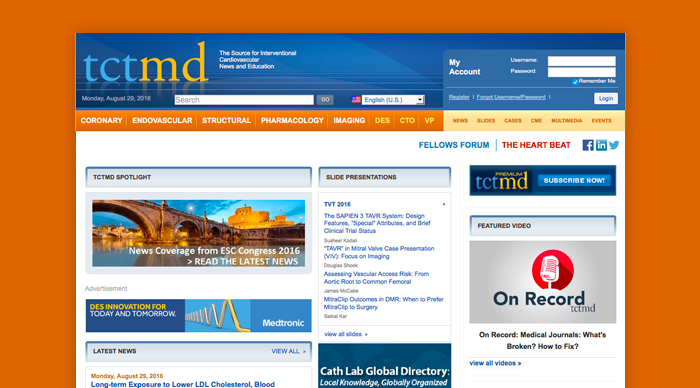
Before Redesign: A Nonprofit Healthcare Research Website in Need of Serious Treatment
With just one significant redesign in its 16-year history, TCTMD was a healthcare nonprofit website from a bygone era. On the back-end, CRF’s data was stuck on an expensive, proprietary Ektron CMS that made it impossible for the healthcare research nonprofit’s editorial team to publish and manage content on their website. TCTMD’s system failed to support the complexity of its content relationships, site search was ineffective, and integration with Salesforce for gated member-only content was clunky and error-prone. To users, the content-heavy website suffered with a confusing taxonomy and navigation that made finding content a chore, visual design made scanning pages and long-form reads uninspiring, and the TCTMD brand failed to embody front-of-field interventional cardiology news and education.
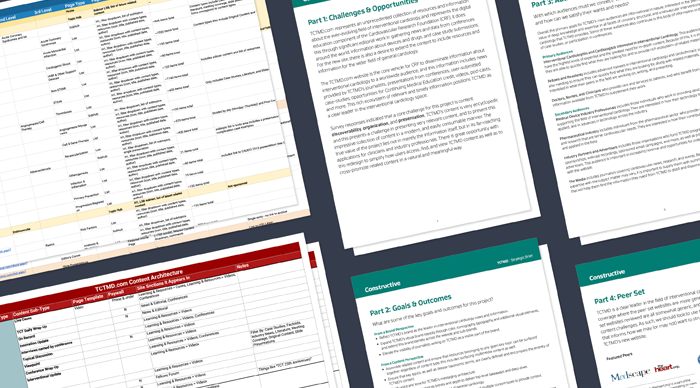
A New Digital Strategy to Drive Engagement With Specialized Healthcare Research Content
TCTMD is truly an encyclopedic website, with tens of thousands of slide presentations, news articles, and videos. The key to success in designing content-heavy nonprofit websites starts with digital strategy and content strategy. And with thousands of pieces of content to make sense of, we quickly got to work understanding the nonprofit website, from multiple perspectives. Discussions with TCTMD’s leadership and editorial team informed goals, pain points, and priorities. A content audit showed how volumes of content were organized. Focus groups, user surveys, and user profiles clarified what was most important to audiences.
An in-depth analysis of CRF’s digital ecosystem detailed the network of connected systems in the nonprofit’s technology infrastructure—and opportunities for us to improve both the user experience and operational efficiencies. Peer analysis placed TCTMD in context to competitors in its space. After learning from CRF’s team, we developed a digital strategy that provided our roadmap for uniting branding, content, design and technology into an nonprofit website that would make a meaningful difference for how The Cardiovascular Research Foundation advances healthcare.
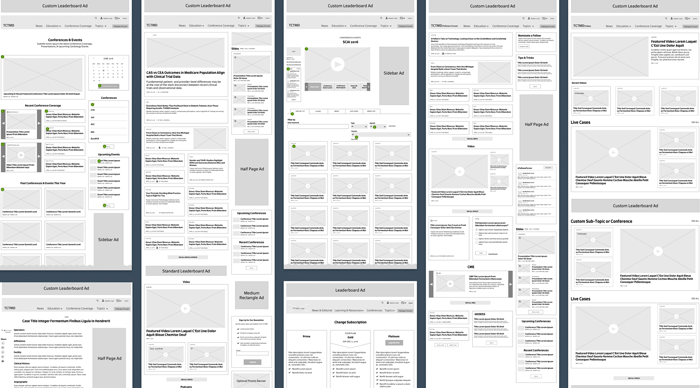
Architecting a User Experience That Delivers Greater Value and Drives Revenue
When it comes to designing research-heavy nonprofit websites, there are best practices to driving content engagement. And in designing the user experience for TCTMD, one of our top priorities was to expose readers who typically visit for one type of content to the volumes of valuable, related content that The Cardiovascular Research Foundation has to offer healthcare experts from its other departments. In particular, TCTMD is a rare membership and community nonprofit website that relies on paid advertising to drive the revenue that supports its programming. Given the volume of news and educational content in TCTMD, this meant developing a content taxonomy that supported existing content and planned for growth, displaying a breadth of relevant options in every view, and not over-stuffing pages and bombarding users to ensure a great reading experience across devices.
With thousands of pieces of specialized content for audiences to engage with, making sure that TCTMD’s website search was exceptional at delivering the results that people were looking for was critical. To ensure content accessibility, we rearchitected the nonprofit website’s search with powerful faceting and filtering search tools powered by SOLR, delivering rapid, accurate results search results.
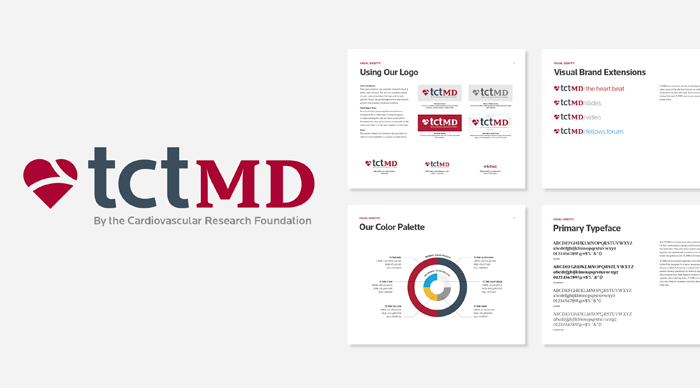
Designing a Logo & Branding That Resonates With Healthcare Experts
Like most major website redesigns, designing TCTMD for The Cardiovascular Research Foundation was both an opportunity to design a great nonprofit website for the healthcare sector and to strengthen the TCTMD brand so that it would stand out among it’s peers like TheHeart.corg by Medscape. Working within CRF’s master brand guidelines for the parent brand, we collaborated with CRF’s team on a rebranding for TCTMD that provided the visual foundation we needed. Two key considerations for designing effective nonprofit branding for The Cardiovascular Research Foundation were ensuring that TCTMD worked within CRF’s master brand, and that its new visual identity would support a brand architecture for TCTMD sub-brands and departments. The resulting design modernizes TCTMD’s brand, while a color and typography system and sub-brand identities provide the structure needed to support brand consistency across all communications in different media and venues.
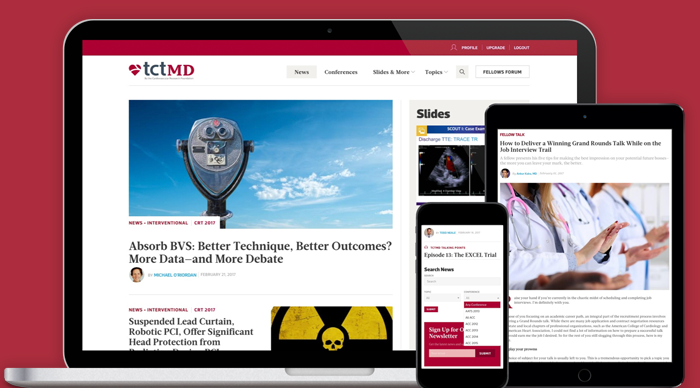
Designing a Nonprofit Healthcare Website that Strengthens Connections to the Brand
With TCTMD’s new logo and branding in place to guide website design, we transformed our wireframes and technical specifications into a a content-driven nonprofit website experience that ensures legibility, accessibility, and deeper engagement with everything that The Cardiovascular Research Foundation has to offer. In keeping with TCTMD’s status as a leading nonprofit website for interventional cardiology news and education, design emphasizes best practices in news and media website design so that TCTMD stands up, stands out, and stands for something among it’s peer set of other healthcare nonprofit websites.
Because of its volumes of long-form content, in particular, Constructive’s team designed TCTMD with a careful, structured typographic hierarchy that makes content scannable, elevates top-level takeaways, and encourages readers to go deeper into the nonprofit website’s extensive content on cardiovascular healthcare. A clear and clean design that establishes a strong visual hierarchy increases usability by making clear what TCTMD’s different editorial departments, topics, and formats are to guide users through the website’s content-heavy pages. And videos and presentations, two of TCTMD’s most valuable types of content, are elevated with calls-to-action that focus attention on member-only content to help drive subscriptions.

Designing a Robust Infrastructure for Digital Transformation
Digital transformation may be all the rage in business settings, but the truth is that digital transformation for nonprofits is an enormous opportunity to streamline service and improve the brand experience. We built TCTMD in Drupal to ensure that the system could handle the large number of complex integrations with The Cardiovascular Research Foundation’s external technology infrastructure. The website makes it easy for subscribers to login using Single-Sign-On, providing tiered member accounts based on the level of subscription and centralized user management control for CRF’s staff. On the content side, TCT provides public content and members-only content access, extensive multimedia content—from video and streaming to automated presentation processing from annual conferences, SOLR search, and custom application APIs.
As one of the top-rated websites in the cardiovascular healthcare sector, TCTMD is also a website that’s visited by thousands of people every day—meaning it needed to effortlessly push all of its media content without slowing down. To meet the need, Constructive’s technology team worked closely with TCTMD to select hosting and complementary technology partners to architect a cloud-based infrastructure to handle the load and evolve with their needs—creating a highly-available, scalable infrastructure with automated deployments, elastic scaling, healing, notification, and more.

The Results
“Constructive completely understood the challenges we were facing in our space. Instead of only having one person be familiar with our project, it seemed that the entire Constructive team was fully invested in making our success be theirs, and vice versa. Their entire team made itself fully available to us, often going above-and-beyond to make our launch successful. We didn’t feel like we hired a company to perform a website redesign, but rather found a partner to work with us and bring our vision to life.”
Stephanie Gutch, Sr. Director of Digital, Cardiovascular Research Foundation
Learn More About Our Work
Get an up-close and detailed look at this project in our visual case study or explore Constructive’s design for healthcare & social services nonprofits.
The Paraprofessional Healthcare Institute (PHI) is the leading direct care policy and advocacy nonprofit in America, transforming eldercare and disability services by fostering dignity, respect, and independence—for all who receive and provide care. In a workforce that is represented by a majority of women and people of color, PHI works as a tireless advocate for equity for direct healthcare workers. They also promote economic opportunity by increasing high-quality direct care jobs. And having just completed a strategic planning process, PHI needed to center the nonprofit’s policy and advocacy website design on its new brand strategy.
Specifically, PHI wanted their new digital strategy to help the nonprofit raise awareness of the key issues, engage a diversity of audiences, create unity across their work streams and engage a diversity of audiences to increase PHI’s policy leadership, raise issue awareness, make their research and support tools more accessible.

A Content-Heavy Nonprofit Website Design Creating Confusion
PHI’s existing website had several key problems that were holding them back. First was that the nonprofit’s website design no longer reflected their new strategic model. Rather than making it easy to understand the issues and PHI’s strategy to address them, it forced people into old, disconnected organizational silos. Second, PHI had just completed a rebranding, leaving them with a website design at odds with their identity. And third, like many content-heavy nonprofit websites, PHI’s had become cluttered. Confusing navigation and poor website search made it hard for people to find what they want and overly text-heavy pages failed to keep users engaged. And because they are a policy and advocacy nonprofit working in a specialized sector, PHI’s website used jargon rather than communicating in accessible terms.
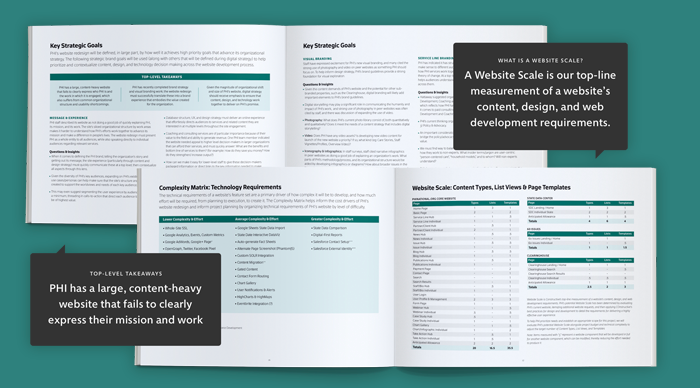
Starting With Discovery to Design a Strategic Nonprofit Website
The nonprofit’s team, of course, had a long list of things that they wanted to change, improve, and add so that their new policy and advocacy website design would make a bigger difference in their mission. They just didn’t know where to start or what accomplishing their goals would entail. To help everyone make sense of it all, we started with a dedicated strategic discovery phase to understand the current website, establish clear goals for a new website design, and create detailed requirements to achieve them.
First, we audited the nonprofit’s website, content, and technology systems. We then led digital strategy workshops with PHI’s leadership to understand their operations, identify pain points, explore solutions, and prioritize needs. We then developed a strategic plan for policy and advocacy nonprofit website design that focuses on what matters most—detailing the strategic, creative, and technical requirements with a roadmap and budget that aligned PHI’s team and ours to support their new brand strategy.
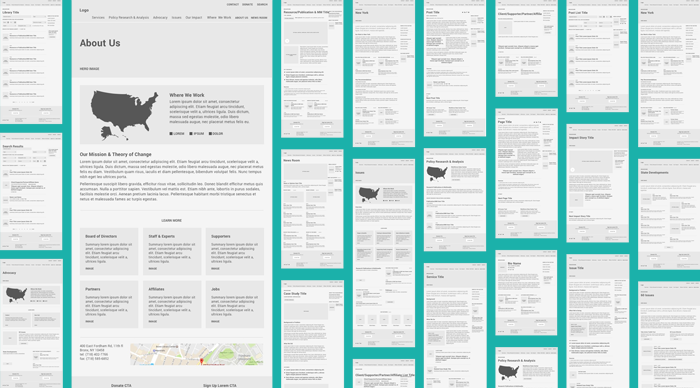
Nonprofit UX Design That Eliminates Organizational Silos and Supports Brand Strategy
PHI is a complex healthcare policy and advocacy nonprofit, providing a wide range of services that support and strengthen the direct care sector. Unfortunately, PHI’s fragmented website was siloed and failed to support their breadth and depth of services. The nonprofit’s website is also content-heavy with resources that need to be accessible and engaging to support their policy and advocacy work.
We also needed to make sure that the design of such a content-heavy policy and advocacy website made sense to real people. To design a more useful experience, we started with user research to give us valuable perspective we can’t have on our own. Analytics analysis deepened our understanding of how people were using PHI’s website, giving us an evidence-based foundation to design a new user experience.
As with all nonprofit websites, our UX strategy stayed focused on raising issue awareness. We designed a site structure that bridges PHI’s silos—organizing ideas by issues, geography, and services; and framing the issues within broader social context to focus on the mission. The result paints a clear picture of who PHI is, what they do, and why they matter—and makes their volumes of policy and advocacy resources readily available.
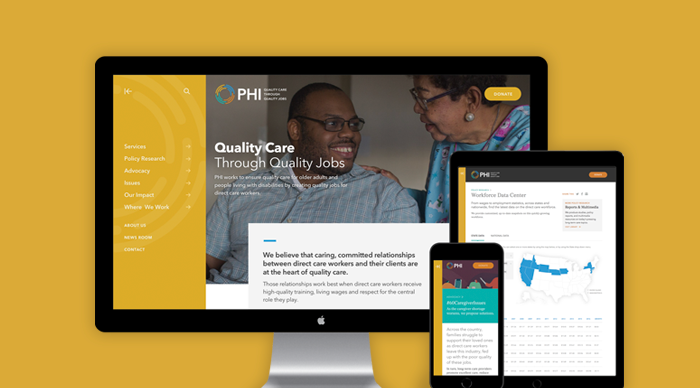
Nonprofit Policy and Advocacy Website Design That’s as Engaging as it is Useful
Designing brand experiences for certain research-focused policy and advocacy nonprofits presents an interesting challenge. By definition, they rely on research that’s often wonky and technical. They speak to subject matter experts and policymakers who are looking for evidence-based expertise. At the same time, every policy and advocacy nonprofit’s work is about social impact. It’s driven by values, and is ultimately about the impact on real people and the planet.
To help PHI balance these two essential aspects of their brand, we designed a website that’s both structured and dynamic. Bold brand colors set the tone within rhythmic grids that keep PHI’s long-form research content engaging. It uses authentic, representative imagery that embody the dignity and compassion that are the heart of the direct care workforce. The results are a website design for a policy and advocacy leader that both creates emotional connections to the direct care issues and people and communicates the rational rigor needed to lead on them with great credibility.
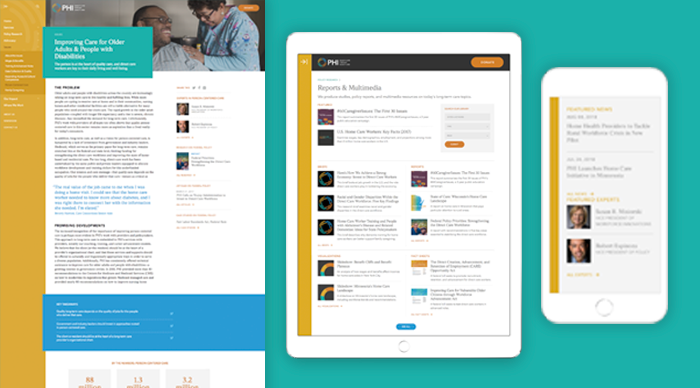
Policy and Advocacy Nonprofit Website Design That Elevates the Issues and the Experts
Central to PHI’s digital strategy is helping audiences understand complex issues facing the direct care workforce. To advance the nonprofit’s leadership at the national, regional, and state levels, we designed PHI’s website with a combination of editorial design techniques and best practices in digital storytelling for nonprofits.
Design engages both expert and lay audiences by delivering top-level takeaways and inviting deep dives into PHI’s content. PHI’s website follows through on our goal of by elevating PHI’s expertise with a library center of PHI’s reports, briefs, and multimedia—and a dedicated National Direct Care Workforce Resource Center that makes it easy for experts to leverage PHI’s research.
The result positions PHI as the leader of one of the fastest-growing sectors of the healthcare industry, delivering a wealth of expertise, insights, resources, and results. It also embodies a tireless advocate and educator for the direct care workforce, a rigorous policy research expert, and a strong voice who raises awareness.
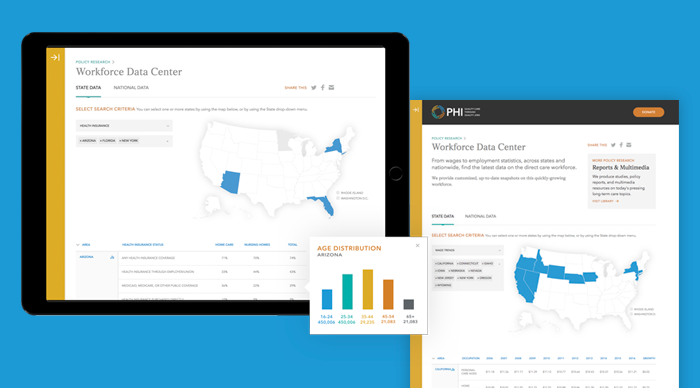
Designing Data Visualization to Deepen Understanding of the Direct Care Workforce
As the leading national expert of the direct care sector, PHI supports the work of policy and advocacy efforts with large-scale, data-driven research on wages and employment statistics for every state and nationwide. Drawing on our team’s expertise in designing data visualization indexes for nonprofit issues such as health equity, the global environment, and the economic impacts of climate change, we turned PHI’s tabular data sets into a dynamic Workforce Data Center.
The new digital data visualization tool contains one of the most comprehensive data sets in the world on the direct care workforce. The interactive data tool empowers users to create customized, comprehensive, up-to-date snapshots that explore issues from race, gender, age, and employment status, to earnings, wage trends, and insurance at the state and national levels.
The Results
“Constructive is fantastic to work with, and our entire collaboration process reaffirmed that we had chosen the right partner. They’re personable and bring a team of experts in different aspects of branding and website development to our relationship. They ask hard questions that force us to think through things we wouldn’t have otherwise. They’re thorough and solutions-oriented. They’re able to both answer high-level strategic questions and focus on executing the details. And they met our deadline, which is rare in website redesigns!” – Robert Espinoza, Vice President of Policy
—————————
Learn More About Our Work
Get an up-close and detailed look at this project in our visual case study or explore Constructive’s design for healthcare & social services nonprofits.






















